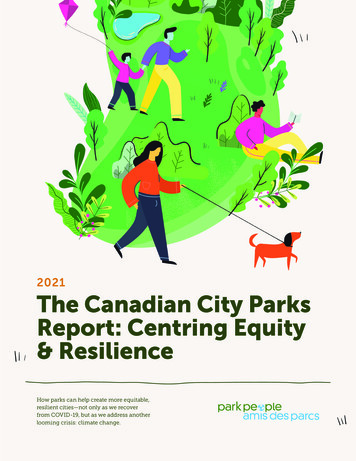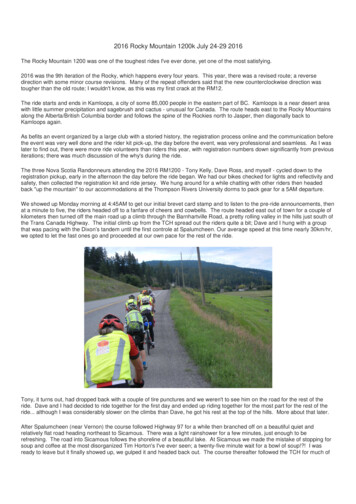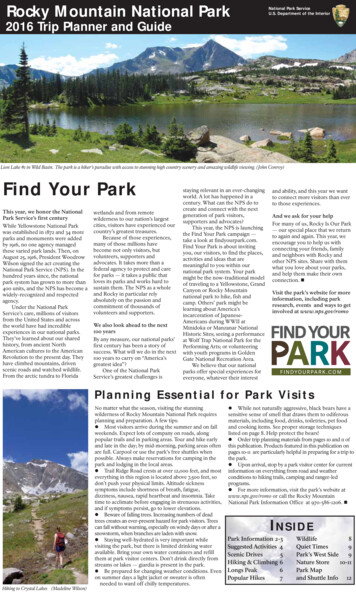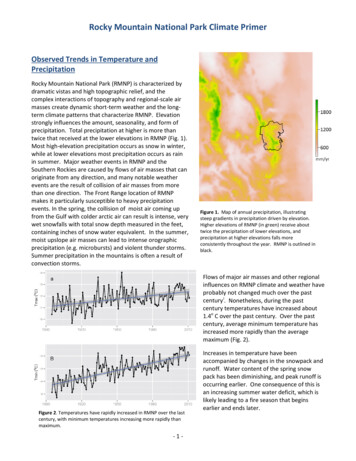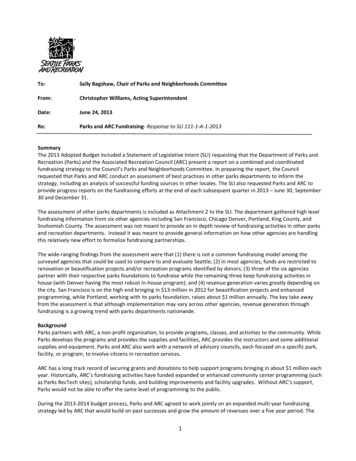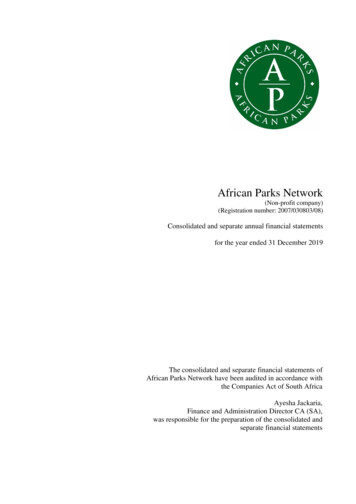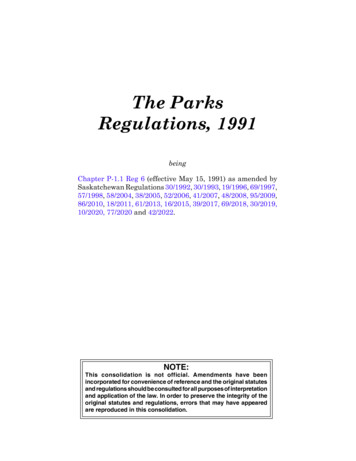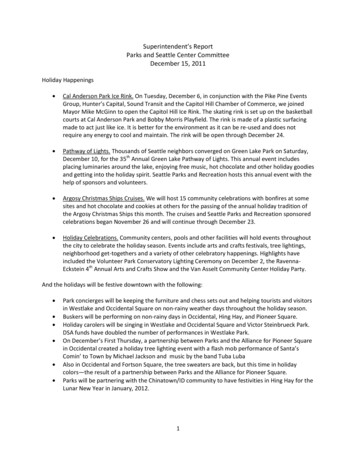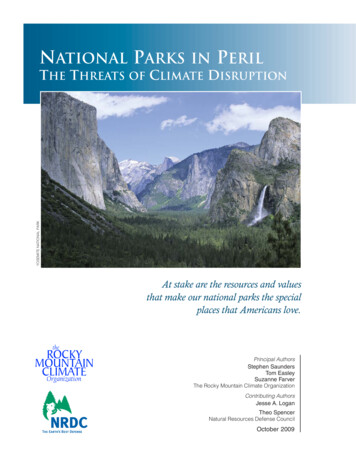
Transcription
NATIONAL PARKS IN PERILYOSEMITE NATIONAL PARKTHE THREATS OF CLIMATE DISRUPTIONAt stake are the resources and valuesthat make our national parks the specialplaces that Americans love.theROCKYMOUNTAINCLIMATEOrganizationPrincipal AuthorsStephen SaundersTom EasleySuzanne FarverThe Rocky Mountain Climate OrganizationContributing AuthorsJesse A. LoganTheo SpencerNatural Resources Defense CouncilOctober 2009
NATIONAL PARKS IN PERILTHE THREATS OF CLIMATE DISRUPTIONA Report byThe Rocky Mountain Climate OrganizationandNatural Resources Defense CouncilPrincipal AuthorsStephen SaundersTom EasleySuzanne FarverContributing AuthorsJesse A. LoganTheo SpencerNatural Resources DefenseCouncilOctober 2009theROCKYMOUNTAINCLIMATEOrganizationROCKY MOUNTAIN NATIONAL PARK / PHOTO: JOHN FIELDERThe Rocky Mountain ClimateOrganization
About RMCOAcknowledgementsThe Rocky Mountain Climate Organization works tokeep the interior American West special by reducingclimate disruption and its impacts in the region. We dothis in part by spreading the word about what a disrupted climate can do to us and what we can do aboutit. Learn more at www.rockymountainclimate.org.The authors would like to thank the following for theirassistance: from the National Park Service, DanaBacker, Perry Grissom, and Meg Weesner, SaguaroNational Park; Mike Bilecki, Fire Island National Seashore; Mike Britten, Rocky Mountain Inventory andMonitoring Network; Gregg Bruff, Pictured Rocks National Lakeshore; Sonya Capek, Pacific West Region;Shawn Carter, Inventory and Monitoring Program; ChasCartwright and Paul Ollig, Glacier National Park; SteveChaney, Redwood national and state parks; RoryGauthier, Bandelier National Monument; BobKrumenaker, Apostle Islands National Seashore; MarkLewis, Biscayne National Park; David Manski, AcadiaNational Park; Joy Marburger, Great Lakes Researchand Education Center; Julie Thomas McNamee, JohnRay, and Chris Shaver, Air Resources Division; GeorgeSan Miguel, Mesa Verde National Park; Duncan Morrow, Office of the Director; Don Neubacher, Point ReyesNational Seashore; Kathryn Parker, Grand CanyonNational Park; Kyle Patterson and Judy Visty, RockyMountain National Park; Jon Riedel, North CascadesNational Park; Charisse Sydoriak, Sequoia/Kings Canyon national parks; Leigh Welling, Natural Resourceand Science Program; and Jock Whitworth, Zion National Park. From the U.S. Geological Survey, CraigAllen, Jemez Mountain Field Station; Jill Baron, FortCollins Science Center; Erik Beever, Alaska ScienceCenter; Julio Betancourt, National Research Program;and Daniel Fagre, Northern Rocky Mountain ScienceCenter. From the U.S. Forest Service, Barbara Bentzand Linda Joyce, Rocky Mountain Research Station;and Kathy O’Halloran, Olympic National Forest. Also,Jeffrey Hicke, University of Idaho; David Inouye, University of Maryland; Melinda Kassen, Colorado TroutUnlimited; Jeremy Littell, University of Washington;Abraham Miller-Rushing, U. S. National PhenologyNetwork; James Patton, University of California, Berkeley; Chris Ray, University of Colorado; MoniqueRocca, Colorado State University; Dave Watts; MarkWenzler, National Parks Conservation Association;Chris Bui and Joshua German, Rocky Mountain ClimateOrganization legal interns; and an anonymous editor.We thank John Fielder (www.johnfielder.com) for lettingus use so many of his photographs. Photos not otherwise credited are from iStockphoto.About NRDCNRDC (Natural Resources Defense Council) is a national nonprofit organization with more than 1.2 millionmembers and online activists. Since 1970, our lawyers,scientists, and other environmental specialists haveworked to protect the world’s natural resources, publichealth, and the environment. NRDC has offices in NewYork City, Washington, D.C., Los Angeles, San Francisco, Chicago and Beijing. Visit us at www.nrdc.org.About the authorsStephen Saunders is president of the Rocky MountainClimate Organization and former Deputy AssistantSecretary of the U.S. Department of the Interior overthe National Park Service. Tom Easley is director ofprograms at RMCO and a former statewide programsmanager at the Colorado State Parks agency. SuzanneFarver is director of outreach at RMCO. Jesse A. Logan is an entomologist, now retired from the U.S. Forest Service. Theo Spencer is a senior advocate inNRDC’s Climate Center.theROCKYMOUNTAINCLIMATEOrganizationThe Rocky Mountain Climate OrganizationP.O. Box 270444, Louisville, CO 800271633 Fillmore St., Suite 412, Denver, CO al Resources Defense Council40 West 20th Street, New York, NY 10011212-727-2700 / Fax 212-727-1773Washington / Los Angeles / San Franciscowww.nrdc.orgCopyright 2009 by the Rocky Mountain ClimateOrganization and Natural Resources Defense CounciliiT
TABLE OF CONTENTSExecutive Summary . vIntroduction . 1Chapter 1. National Parks Most at Risk . 3Chapter 2. Loss of Ice and Snow . 7Chapter 3. Loss of Water. 11Chapter 4. Higher Seas and More Extreme Weather . 15Chapter 5. Loss of Plant Communities . 19Chapter 6. Loss of Wildlife . 25Chapter 7. Loss of Historical and Cultural Resources. 33Chapter 8. Less Visitor Enjoyment. 35Chapter 9. Recommendations . 39PHOTO: JOHN FIELDERNotes. 48iii
ivROCKY MOUNTAIN NATIONAL PARK / PHOTO: JOHN FIELDER
RECOMMENDATIONSEXECUTIVE SUMMARYZION NATIONAL PARKNational Parks Most At Peril Acadia National Park Assateague Island National Seashore Bandelier National Monument Biscayne National Park Cape Hatteras National Seashore Colonial National Historical Park Denali National Park and Preserve Dry Tortugas National Park Ellis Island National Monument Everglades National Park Glacier National Park Great Smoky Mountains National Park Indiana Dunes National Lakeshore Joshua Tree National Park Lake Mead National Recreation Area Mesa Verde National Park Mount Rainier National Park Padre Island National Seashore Rocky Mountain National Park Saguaro National Park Theodore Roosevelt National Park Virgin Islands National Park/Virgin IslandsCoral Reef National Monument Yellowstone National Park Yosemite National Park Zion National ParkTHE GREATEST THREAT TONATIONAL PARKSHuman disruption of the climate is the greatestthreat ever to our national parks.This report focuses primarily on 25 nationalparks that we identify as having the greatestvulnerabilities to human-caused climate change.They face 11 different types of risks.A loss of ice and snow is one of the mostobvious impacts of a changing climate. Glaciersare melting in our national parks, a handful ofwhich contain the vast majority of the nation’sglaciers. In many national parks, snow-coveredmountains contribute to some of the most spectacular scenery in the nation. But higher temperatures,less snowfall, and earlier snowmelt are alreadyleading to declines in mountain snowpack across theWest. With less snow, fewer visitors will be able tosee snow-capped mountains in parks. Opportunitiesfor cross-country skiing, snowshoeing, and otherwinter activities in parks also will be reduced. (Seepages 7-10.)For a summary of how losses of ice and snow,and other impacts, are already underway in nationalparks, see the next page.Parks in the West and along the Great Lakes facea loss of water. In the West, a changed climate willreduce water availability, especially in the summer.The Colorado Plateau, home to our largest concentration of national parks, is expected to get particularly hotter and drier. In Zion National Park, reductions in river flows could change how the Virgin Riveris continuing to shape Zion Canyon. Water levels ofthe Great Lakes are likely to fall, affecting ecosystems and recreation in Great Lakes parks. (Seepages 11-14.)The 74 national parks on our coasts face higherseas and stronger coastal storms. Depending onfuture emissions of heat-trapping gases, seas areexpected to rise from about 2.3 feet to 3 or 4 feet bycentury’s end. Nearly all of Everglades, Biscayne,and Dry Tortugas national parks and Ellis IslandNational Monument are less than that above thecurrent sea level. All four parks could be lost to risingseas, representing the first-ever losses of entirenational parks. (See pages 15-18.)v
How National Parks Are Already ChangingGGlaciers are already melting in all national parks thathave them, including Denali, Mount Rainier, andYosemite national parks. All glaciers in GlacierNational Park could be gone in 12 or 13 years. (Seepages 7-9.)Mountain parks are already losing late-summerstreamflows as smaller glaciers produce lessmeltwater. In one glacier-fed watershed in NorthCascades National Park, summer flows already aredown 31 percent. (See page 9.)In the West, more winter precipitation is alreadyfalling as rain rather than snow, and snow is meltingearlier. Western parks already have less mountaintopsnow in spring and summer. (See pages 9-10.)In Yellowstone National Park, the winter season forsnowcoaches and snowmobiles already is starting inDecember or even January rather than November.(See page 10.)The Colorado Plateau already has both drierconditions and the greatest temperature increase inthe 48 contiguous states. In Bandelier NationalMonument and Mesa Verde National Park, as manyas 90 percent of piñon pines have died. (See page12.)The coastal barrier island of Assateague IslandNational Seashore, already hammered by a risingsea level and coastal storms, is not far from beingbroken apart by the sea. (See page 16.)The National Park Service has already had tomove Cape Hatteras Lighthouse inland to keep itabove the rising sea. (See page 34.)Across the country, more heavy storms alreadyare producing bigger downpours. A heavy downpourin 2006 flooded Mount Rainier National Park so muchthat it was closed for six months. (See page 18.)Western mountains already are hot enough thattree-killing bark beetles are spreading to higherelevations than before and reproducing faster, insome places with one generation each year insteadof one every three years. In Rocky Mountain NationalPark, nearly all mature lodgepole pine trees arebeing killed by beetles. (See pages 19-21.)In Yosemite and Sequoia/Kings Canyon nationalparks and other spots across the West, trees of alltypes and ages are dying at faster rates than before.(See page 21.)viIn Yosemite, winters have already warmed up somuch that the lower-elevation edges of coniferforests are dying out and being replaced by oak andchaparral. (See pages 21-22.)In Saguaro National Park, hotter temperaturesalready are promoting the spread of buffelgrass, aninvasive species that brings wildfire into the desertecosystem for the first time, threatening saguarosand other native desert species. (See page 22.)In Yellowstone National Park, mountain pinebeetles already are infesting higher elevations thanbefore and threatening to wipe out whitebark pines, amountaintop species. Their nuts are such an important pre-hibernation food for the region’s grizzlybears that reduced whitebark pine nuts lower grizzlybirth rates. (See page 28.)Pikas, mountaintop mammals especially sensitiveto warm temperatures, already have been eliminatedin several of the lower-elevation mountains they usedto inhabit. (See page 26.)In Yosemite National Park, mammals already arechanging where they live by moving to higherelevations. (See page 26.)In Rocky Mountain National Park, mountaintoptundra areas already are warming up earlier in thespring, which is linked to a 50 percent decline inwhite-tailed ptarmigan, which live on the tundra yearround. (See page 27.)In Yosemite and Sequoia/Kings Canyon nationalparks, conditions already are hotter and drier,apparently driving a 10 percent per year decline inmountain yellow-legged frogs. (See page 29.)In Yellowstone National Park’s Firehole River in2007, temperatures already were hot enough forseveral days to kill as many as a thousand trout inthe largest documented fish kill in the park’s 135year history. (See page 30.)In Virgin Islands National Park, 50 percent of thecorals in the park’s coral reefs have died since 2006from causes related to excessive water temperatures. (See page 31.)In Yellowstone National Park, summer heat hasalready become excessive enough to stress trout,which are coldwater fish, prompting the NationalPark Service to close 232 miles of rivers to fishing.(See page 37.)
More downpours and flooding are occurringeverywhere, as a changing climate already is leadingto more precipitation coming in heavy storms. Theforecast is for the heaviest precipitation events tocontinue getting stronger, causing erosion andflooding that threatens resources in virtually all parks.(See page 18.)An altered climate is leading to a loss of plantcommunities of parks, including a disruption ofmountain forests, tundra, meadows, and wildflowers;of desert ecosystems; and of coastal plant communities. In Saguaro National Park, saguaros could beeliminated, and in Joshua Tree National Park, Joshuatrees could be eliminated. (See pages 19-24.)A loss of wildlife in parks is projected to resultfrom a changed climate, as some species may gocompletely extinct and some local wildlife populations in particular parks may be eliminated or declinesharply. Among the populations that are vulnerableare grizzly bears in Yellowstone and Grand Tetonnational parks, lynx, Florida panthers, pikas, mountain and desert bighorn sheep, white-tailed ptarmigan, sooty terns, sea turtles, amphibians, trout,salmon, corals, and butterflies. (See pages 25-32.)Higher seas, stronger coastal storms, andincreased downpours and flooding threaten a lossof historical and cultural resources in nationalparks. At particular risk are Ellis Island NationalMonument in Upper New York Bay, less than threefeet above the current high tide level, through whichpassed the arriving ancestors of 40 percent of allliving Americans; the Statue of Liberty NationalMonument, also in Upper New York Bay; and theJamestown National Historic Site, part of ColonialNational Historical Park in Virginia, where the firstEuropean ancestors of today’s Americans arrived in1607. (See pages 33-34.)National parks in the hottest parts of the countrycould suffer intolerable heat, simply becoming toohot for long stretches of the year for many people.Under a higher-emissions future, Big Bend, DeathValley, Joshua Tree, and Saguaro national parks,Mojave National Preserve, and Lake Mead NationalRecreation Area are projected to average more than100 days a year over 100 F. Those parks, Biscayneand Everglades national parks, and Big CypressNational Preserve are projected to average 90 F orhotter for half or more of the entire year. (See page35-36.)As temperatures soar with a changed climate,cooler northern and mountain parks and nationalseashores could experience overcrowding as peopleflock to them to escape oppressive heat. (See pages36-37.)Hotter temperatures could sharply reducepopulations of trout and salmon, which are coldwaterfish species, and lead to a l oss of fishing in nationalparks. Damage to coral reefs and other marineresources also could reduce sportfishing in coastalparks. (See pages 37-38.)A hotter climate is also projected to lead to moreair pollution in parks by worsening concentrationsof ground-level ozone, the key component of smog.Many national parks already violate the health-basedair quality standard for ozone, and that air pollutionproblem could get worse with a changed climate.(See page 38.)vii
RECOMMENDATIONSThis report recommends 32 actions specific tonational parks, including: The Congress, the Administration, and the NPSshould set aside new national parks and expandexisting parks as necessary to preserve for futuregenerations representative and sufficient examples of America’s best natural and culturalresources. The NPS should promote, assist, and cooperatein preservation efforts beyond park boundaries topreserve large enough ecosystems, crucialhabitat, and migration corridors so that plants andanimals have opportunities to move and continueto survive in transformed landscapes. The Congress, the Executive Branch, and theNPS should consider the combined effects ofclimate change and of other stresses on parkresources and values, and work to reduce all thestresses that pose critical risks to parks. The NPS should develop park-specific andresource-specific plans to protect the particularresources most at risk in individual parks. The NPS should use all its authorities to protectparks from a changing climate, including its“affirmative responsibility” under the Clean Air Actto protect the air-quality related values of nationalparks. The NPS should adopt a nationwide goal ofbecoming climate-neutral in its own operationswithin parks, as has been adopted by its PacificWest Region. The Service should give an evengreater priority to reducing the greater levels ofemissions coming from visitor activities. NPS officials should speak out publicly about howclimate change and its impacts threaten nationalparks and the broader ecosystems on which theydepend. The NPS should use its environmental educationprograms to inform park visitors about a changedclimate and its impacts in parks and about whatviiiis being done in parks to address climate changeand its impacts. The NPS should require concessionaires to do so, too. The Congress and the Administration shouldadequately fund NPS actions to address achanging climate, through the energy and climatelegislation now in Congress, through new NPSauthority to use entrance fees to reduce emissions of heat-trapping gases and addressimpacts in parks, and through funding of theLand and Water Conservation Fund. The Congress and the Administration shouldreestablish within the NPS the scientific andresearch capacity it had prior to 1993, by returning to NPS the programs and staff transferred thatyear to the U.S. Geological Survey.Ultimately, to protect our national parks for theenjoyment of this and future generations, federalaction to reduce heat-trapping gases is needed sothat a changed climate and its impacts do notoverwhelm the parks. The federal government musttake three essential steps: Enact comprehensive mandatory limits on globalwarming pollution to reduce emissions by at least20 percent below current levels by 2020 and 80percent by 2050. This will deliver the reductionsthat scientists currently believe are the minimumnecessary, and provide businesses the economiccertainty needed to make multi-million and multibillion dollar capital investments. Overcome barriers to investment in energyefficiency to lower emission reduction costs,starting now. Accelerate the development and deployment ofemerging clean energy technologies to lowerlong-term emission reduction costs.ROCKY MOUNTAIN NATIONAL PARKPHOTO: JOHN FIELDERAs the risks of a changed climate dwarf all previousthreats to our national parks, new actions to facethese new risks must also be on an unprecedentedscale. Needed are both actions specific to parks topreserve their resources and actions to curtailemissions of climate-changing pollutants enough toreduce the impacts in parks and elsewhere.
EVERGLADES NATIONAL PARKINTRODUCTIONTHE GREATEST THREAT TONATIONAL PARKSHuman disruption of the climate is the greatest threatever to our national parks.This is not just a concern for the future. Thenational parks that we Americans so cherish arealready being harmed by a changing climate. InYosemite National Park, trees of all types and agesare dying more often, and both forests and mammalsare moving upslope to stay ahead of higher temperatures. Yellowstone National Park is losing its whitebark pines and their nuts, so important as a food forgrizzly bears that fewer whitebark nuts before hibernation mean lower grizzly birth rates the followingyear. Summers in Yellowstone now are sometimes hotenough to kill trout, which are cold-water fish thatcannot tolerate hot waters. Rocky Mountain NationalPark is losing its mature lodgepole pines. BandelierNational Monument and Mesa Verde National Parkhave lost most of their piñon pines. Mount RainierNational Park was recently shut down for six fullmonths because of extreme flooding, an example ofthe extreme weather now occurring more often.If we continue heedlessly adding heat-trappingpollution to the atmosphere, we could lose wholenational parks for the first time. Nearly all of Everglades, Biscayne, and Dry Tortugas national parks,as well as Ellis Island National Monument, are barelyabove the current sea level, lower than the projectedrise in the sea. All four parks could be lost to risingseas. Glacier National Park could lose all its glaciers.Virgin Islands Coral Reef National Monument couldlose all its coral reefs. Joshua Tree National Parkcould lose all its Joshua trees. Saguaro National Parkcould lose all its saguaros.Of course, climate change is a global phenomenon, with global causes and effects. Why focus on“National parks that have special places in theAmerican psyche will remain parks, but theirlook and feel may change dramatically.”U.S. Climate Change Science Program (2008)1national parks? Because the parks have been setaside to preserve, unimpaired, the very best of ournatural and cultural heritages, and to provide for theircontinued enjoyment by future generations. To ignorethe enormous threats a changed climate poses tonational parks because other places are alsothreatened would be to give up on our parks.Instead, we can identify and address the threats toparks, through actions both to reduce the effects ofclimate change in parks and to reduce the causes ofclimate change. And in dealing with human-causedclimate change in the national parks, we can learnand demonstrate how to deal with it elsewhere. Thatis in the best traditions and interests of the nationalparks and of America.What Happens Is Up to UsThe climate is already changing. The world’s scientists, through the Intergovernmental Panel on ClimateChange (IPCC), have declared that it is “unequivocal” that the climate is now hotter than it used to be,with more than a 90 percent likelihood that most ofthe temperature increase over the past 50 years is aresult of human emissions of heat-trapping pollution,mostly from the burning of fossil fuels.2 The planet asa whole so far this century averages about 1 F hotterthan during the 20th century, with particularly sharpincreases in the most recent years.3 Without theeffects of human activities, global temperatures likelywould have cooled since 1950.4How much more the climate changes will bedetermined by how much more heat-trappingpollution we produce. A recent, comprehensiveclimate-change report from the U.S. government’sGlobal Change Research Program estimated that,compared to the 1960s and 1970s, our nation is1
projected to get 7 to 11 F hotter by the end of thecentury under a higher-emissions scenario and byapproximately 4 to 6.5 F under a lower-emissionsscenario.5 These two scenarios differ because ofdifferent assumptions about future populations,technologies, economic activity, and the like. Neitherscenario assumes new policies to reduce emissions,and so it is certainly possible to bring down both theprojected emissions and changes in the climate. Butthe same government report also points out that avariety of studies suggests that even 2 F of additional warming “would lead to severe, widespread,and irreversible impacts.”6 To have a good chance—but still no guarantee—of no more warming than 2 Fover the long term, the report says that atmosphericlevels of heat-trapping gases would have to bestabilized at about today’s level, with no more newemissions than can be removed from the atmosphereby natural processes.7Which future we choose will determine what ournational parks, along with the rest of the planet, willbe like. Many of the threats to our national parksdescribed in this report are from scientific projectionsfor a high-emissions future and can be reduced witha lower-emissions future and reduced even furtherwith a stable-climate future. Sadly, though, even themost unsettling projections of a higher-emissionsfuture could turn out to be understatements if we donot change our current ways. In recent years,worldwide emissions of heat-trapping pollutants havegone up faster than the scientists’ high-emissionsscenarios.8Time is running short, but it is still possible tobring down emissions sharply enough to ward off theworst possible effects of climate disruption. The lastchapter of this report contains recommendations onhow we can begin doing that, while also strengthening our economy.Higher Emissions Scenario Projected Temperature ChangeDegrees F ComparedTo 1961-1979BaselineMid-Century (2040-2059 average)End-of-Century (2080-2099 average)Lower Emissions Scenario Projected Temperature ChangeDegrees F ComparedTo 1961-1979BaselineAverage results from16 climate models.Graphics source: U.S. GlobalChange Research Program.92Mid-Century (2040-2059 average)End-of-Century (2080-2099 average)
1DENALI NATIONAL PARKNATIONAL PARKSMOST AT RISKHHuman-caused climate change puts at risk nearlyevery resource and value that makes our nationalparks so special. The scenery of parks is beingaffected as glaciers melt, mountains lose snowcovered peaks, and forests die back. Wildlife isbeing affected by climate-driven changes in habitatand disruptions of food sources. Cultural resourcesare being affected as rising seas, stronger storms,and bigger floods erode historic and prehistoricstructures and wash away artifacts. Visitor enjoymentis being affected as fishing is prohibited, boating iscurtailed, and opportunities for cross-country skiingdiminish.These impacts are imperiling most, if not all, ofthe 391 parks* in the national park system. Thisreport focuses primarily on 25 national parks that weidentify as having the greatest vulnerabilities tohuman-caused climate change. They were chosen,first, based on how much an altered climate mayaffect the overall integrity of a particular park’sresources and values. Parks at risk of being entirelysubmerged by a rising sea obviously are in greateroverall peril than most parks. Second, the parks onthe list reflect both the diversity of the national parksystem and the variety of threats an altered climateposes to parks. Third, the list was necessarilyinfluenced by the information available about theparticular risks individual parks face.Unfortunately, there usually is very little information about how a disrupted climate may affect anindividual park. As the National Park Service (orNPS) and others further assess the impacts ofclimate change on parks, it may become clear thatsome parks not on the list actually have greatervulnerabilities than ones on it. This could especiallybe true for the 17 national parks in Alaska, which sofar has gotten hotter at twice the rate of the rest of*This report refers to all units of the national park system asnational parks or parks, even if they are designated as nationalmonuments, national seashores, or something else. All aremanaged under the same general laws and policies.“We identified the lack of any climaticdata within Glacier Bay as a significantgap in knowledge about a very importantand basic driver of the physical and biological systems within the Park, a sentimentechoed by many Park staff and researchersalike. Although specific funding for climatemonitoring could not be secured, it wasan obvious data gap that we have tried tofill by establishing the current network ofclimate sites.”— Daniel E. Lawson and David C. Finnegan,Dartmouth College (2008) 1the country and which is expected to continuegetting hotter than elsewhere. But how parks inAlaska will be affected is not yet well documented.For now, Denali National Park and Preserve, the oneAlaskan park on our list, should be considered asbroadly representative of the threats to all parks inAlaska.The 25 national parks in greatest peril are identified in the chart on the following pages, which alsoindicates the particular risks faced by each park.There are 11 categories of such risks: a loss of iceand snow, addressed in chapter 2; a loss of water, inchapter 3; higher seas and stronger coastal storms,in chapter 4; more downpours and flooding, also inchapter 4; a loss of plant communities, in chapter 5;a loss of wildlife, in chapter 6; a loss of historical andcultural resources, in chapter 7; and intolerable heat,overcrowding, a loss of fishing, and more air pollution, all in chapter 8.3
25 National Parks Most at Peril fromLoss of Ice& SnowLossof WaterHigher Seas &Stronger StormsMoreDownpours& FloodsLoss of PlantCommunitiesAcadia NP, MEAssateague Island NS, MD/VABandelier NM, NMBiscayne NP, FLCape Hatteras NS, NCColonial NHP, VADenali NP&P, AKDry Tortugas NP, FLEllis Island NM, NY/NJEverglades NP, FLGlacier NP, MTGreat Smoky Mts NP, TN/NCIndiana Dunes NL, INJoshua Tree NP, CALake Mead NRA, NV/AZMesa Verde NP, COMount Rainier NP, WAPadre Island NS, TXRocky Mountain NP, COSaguaro NP, AZTheodore Roosevelt NP, NDVirgin Islands NP/VirginIslands Coral Reef NM, VIYellowstone NP, WY/MT/IDYosemite NP, CAZion NP, UTLegend:NP National ParkNM National Monument4NS National SeashoreNHP National Historical ParkNP&P National Park and PreserveNL National Lakeshore
Climate Disruption and the Risks They FaceLoss ofWildlifeLoss of CulturalResourcesIntolerableHeatMoreOvercrowdingL
Human disruption of the climate is the greatest threat ever to our national parks. This report focuses primarily on 25 national parks that we identify as having the greatest vulnerabilities to human-caused climate change. They face 11 different types of risks. A loss of ice and snowis one of the most obvious impacts of a changing climate.

